| |
Glossary of Coral Reef Terminology - F
facies - a geographical variant of a community, or a variant which includes a conspicuous or abundant species not present in the main community; all of the characteristics of a particular rock unit. The characteristics of the rock unit come from the depositional environment, which puts its own distinctive imprint on the sediment, making a particular facies. Thus, a facies is a distinct kind of rock for that area or environment |
facultative - able to exist under more than one set of environmental conditions. For example, a facultative parasite may exist either as a parasite or as a saprotroph (gaining nutrients from dead organic matter) |
facultative mutualism - mutualism in which one or both species in the association may survive and maintain populations in the absence of the other species |

Fagatele Bay, a National Marine sanctuary in American Samoa. (Photo: NOAA)
|
Fagatele Bay National Marine Sanctuary - Fagatele Bay, located on Tutuila, the largest island of American Samoa, was designated as a National Marine Sanctuary in 1986. It is the smallest and most remote of all the national marine sanctuaries encompassing only 163 acres (.25 sq. mi.). Fagatele is the only true tropical coral reef in the National Marine Sanctuaries Program |
faginism - cannibalism by adults on their young |
Fahrenheit temperature scale - a thermometric scale on which the freezing point of water is at 32 degrees F (Fahrenheit) above the 0 degree (F) mark on the scale, and the boiling point of water is at 212 degrees F |
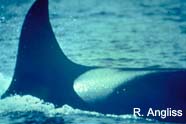
Falcate-shaped dorsal fin of an Orca Whale. (Photo: Robyn Angliss, NOAA/NMML)
|
falcate - scythe-shaped |
falciform - curved like a long, narrow scythe |
falculate - a shape that is curved and sharp-pointed, like a claw |
family - a taxonomic group containing one or more genera |

The fan palm is the only species of tree on the island of Nihoa, in the Northwestern Hawaiian Islands. (Photo: Sheila Conant)
|
fan palm - the only species of tree (Pritchardia remota) on the island of Nihoa in the Northwestern Hawaiian Islands |
FAQ (Frequently Asked Questions) - documents that list and answer the most common questions on a particular subject |
farctate - a filled or solid structure, as opposed to one that is tubular or hollow |
faro - a rhomboid-shaped, steep-sided, continental shelf atoll |
fat - a triglyceride (lipid) that is usually solid at room temperature |
fathom - is a unit of length often used to measure depth of water and is equivalent to 6 feet or 1.8 meters |
fathometer - an instrument for measuring underwater depth using sound |
fatty acid - any of a class of saturated aliphatic monocarboxylic acids that form part of a lipid molecule; a product of fat hydrolysis |
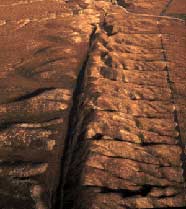
An aerial view of the San Andreas fault in the Carrizo Plain, Central California.(Photo: US Geological survey)
|
fault - a crack or fracture in the Earth's crust accompanied by a displacement of one side of the fracture. Movement along the fault can cause earthquakes or, in the process of mountain-building, can release underlying magma and permit it to rise to the surface |
fault zone - an area in which there are several closely spaced faults |
fauna - the entire group of animals found in an area |

Feather stars care very mobile, but usually they cling by their cirri to sponges or corals. They are very abundant in areas exposed to strong currents, because they feed on plankton.(Photo: Teresa (Zubi) Zuberbühler (www.starfish.ch))
|
feather star - feather stars are echinoderms in the class Crinoidea. The juveniles attach to the substrate by a stalk with rootlike branches. The mouth side faces upward. In the adult stage they break away from the stalk and move about freely.They possess appendages, known as cirri, attached to the underside of the body with which they cling to to sponges or corals. Some can swim by undulating movements of the arms. Some have five arms, others up to 200 |
feces - egested undigested food wastes |
fecundity - the productiveness or potential productiveness of an organism, measured in the number of viable offspring it may produce; the number of eggs an animal produces each reproductive cycle; the potential reproductive capacity of an organism or population |
Federal Geographic Data Committee (FGDC) - coordinates the development of the National Spatial Data Infrastructure (NSDI). The NSDI encompasses policies, standards, and procedures for organizations to cooperatively produce and share geographic data. The 17 federal agencies that make up the FGDC are developing the NSDI in cooperation with organizations from state, local and tribal governments, the academic community, and the private sector |
Federal Information Processing Standards (FIPS) codes - a standardized set of numeric or alphabetic codes issued by the National Institute of Standards and Technology (NIST) to ensure uniform identification of geographic entities through all federal government agencies. The entities covered include: states and statistically equivalent entities, counties and statistically equivalent entities, named populated and related location entities (such as, places and county subdivisions), and American Indian and Alaska Native areas |
Federal waters - generally waters from 3 - 200 miles offshore |
feeding guild - a group of unrelated fishes that feed on similar foods, e.g., benthivore, detritivore, herbivore, insectivore, omnivore, planktivore, piscivore, etc |
feral - existing in a wild or untamed state.The term is often used to describe an animal which has reverted to such a state from domestication. An example of the latter is a once farmed fish, or the progeny of a farmed fish, which is living (but not necessarily breeding) in a wild state |
fermentation - the anaerobic breakdown by microorganisms of complex organic substances, especially carbohydrates, to CO2 and alcohol; fermentation is also used to describe the process by which various chemical or pharmaceutical compounds can be made in large tanks, called fermenters, that contain microorganisms or plant or animal cells, and the nutrients they require to live and grow |
fermi - unit of length equal to one quadrillionth of a meter |
fertilization - the process where a spermatozoan (sperm cell) penetrates the cell membrane of an egg cell and the nuclei of the sperm and egg cells join together and their chromosomes combine to form a diploid zygote |
fetch - the uninterrupted distance over which the wind blows (measured in the direction of the wind) without a significant change of direction |
fibrillose - covered with or containing fibrils |
fibropapillomatosis - a fibroepithelial tumor, probably caused by a herpes-type virus, found in juvenile, subadult, and adult sea turtles, causing them to be emaciated, weak, depressed, and anemic. Affected turtles may have flotation problems resulting from fibrous tumors in the lungs. Fibrous tumors are also found in visceral sites, such as liver, lung, kidney and gastrointestinal tract. |
fide - on the authority of, according to, with reference to a publication or to a cited published statement |
field guide - a pocket-size book or a CD containing taxonomic keys for identification, illustrations and/or photographs of organisms, distribution maps, and some natural history notes |
field research - the study of organisms in their natural habitat |
fila - a thread-like structure, a filament |
filamentous - slender and/or threadlike |

The plainhead filefish, Monacanthus hispidusis, a common inhabitant o coral reefs and seagrass beds in the tropical Atlantic. Strays are often found as far north as New England. (Photo: NOAA)
|
filefish - any species of bony fishes in the family Monacanthidae.The body of filefishes is laterally compressed and roughly diamond-shaped in profile. The filefish gets its name from its very rough skin.The first dorsal fin is essentially a single sharp spine which |
filial - an offspring generation |
filiform tentacle - a long, thin tentacle of a hydrozoan polyp, usually concentrated toward the base |
filter feeder - an organism that feeds by capturing particles suspended in the water column. A synonym of suspension feeder. |

The papillae of this scorpion fish possess a fimbriate appearance.
|
fimbriate - a structure that is fringed at the margin |

Drawing of a bony fish that shows the locations of the median and paired fins. (Graphic: Cristi A. Cave, Stream Biology and Ecology)
|
fin - organ of locomotion and balance in fishes and some other aquatic animals; in fishes, fins are of two types: paired (pectoral and pelvic fins) and unpaired or median (dorsal, adipose, anal, and caudal fins and finlets). Fins of bony fishes contain hard spines and/or soft rays, which may be jointed and branched. The spines and rays are covered by integument. Counts of spines and rays are used as diagnostic characters in fish taxonomy; a membranous, finlike, swimming organ, as in pteropod (having the anterior lobes of the foot modified so as to form a pair of winglike swimming organs), and heteropod (where the foot developed into a median fin) mollusks |

Open heel SCUBA fins with mask and snorkel. This type of adjustable-strap fin is worn over neoprene booties.
|
fin (scuba) - a rubber or plastic shoe-like device attached to the feet to increase surface area for greater thrust while swimming; they may be open heeled or full-footed. Scuba divers prefer the open heel style, usually worn with booties |

Note the thin fin membrane stretched between the hard spines and soft rays of the sergeant major, Abudefduf septemfasciatus (Photo: John E. Randall, Ph.D.)
|
fin membrane - the thin membrane between and connecting fin rays and spines of fishes |
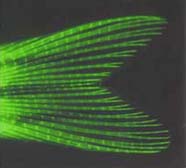
Caudal fin of a fish. The fin is stained with the vital dye calcein which colors calcium/calcified bone matrix. Note the soft segmented fin rays. (Photo: Dr. M. Kathy Lovine, Washington University, St. Louis, MO)
|
fin ray - a slender, rod-shaped structure that supports the membranes of the fins of fishes. There are two types of rays, soft rays and spines. Soft rays are jointed, often branched, and flexible near their tips. Spines are unjointed, unbranched, and usually sharp at the tip and stiff along the shaft |
fine sediment - a sediment composed of fine-grained materials, such as clay or mud particles |
fingerling - a young or small fish |
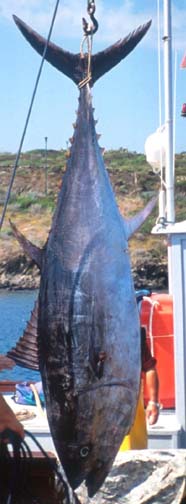
A series of small finlets between the dorsal and anal fins and the tail of a bluefin tuna. (Photo: NOAA)
|
finlet - one of several small non-retractable fins located dorsally and ventrally between the second dorsal and anal fins and the caudal fin of scombroids (mackerals, tuna) and some other fishes, e.g., sauries and snake mackerals. Finlets appear to have a hydrodynamic function in fishes that have been studied for this character |

Fire coral in the Flower Garden Banks National Marine Sanctuary (Photo: Jackie Reid)
|
fire coral - a species of hydroid (Millepora sp.) that frequently is brownish to orange-yellow in color and forms encrusting colonies that can assume the shape of its support structure. Their nematocysts release a virulent toxin which causes painful welts on human skin. Fire corals are not true corals (see Hydrozoa) |
fire wall - a combination of hardware and software that separates a network into two or more parts for security purposes |
first revisor - in zoological nomenclature, the person who first selects one of two or more simultaneously published names that he or she believes represent the same taxon, or who selects which one of two or more taxa the name will apply to for which identical names have been simultaneously published; also applies to first selection of multiple original spellings |
First Revisor (Principal of) - the principle that the relative precedence of two or more names or nomenclatural acts published on the same date, or of different original spellings of the same name, is determined by the first reviser |
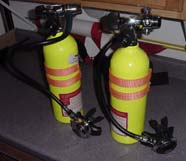
The first stage regulator is attached to the scuba tank. (Photo: NOAA/National Undersea Research Program)
|
first stage regulator - attached to the scuba tank, the first stage regulator reduces the high tank pressure to an intermediate pressure of 100 to 150 psi above the surrounding water pressure |
firth - a partly land-locked arm of the sea |
FISH (fluorescence in situ hybridization) - hybridization of cloned DNA to intact chromosomes, where the cloned DNA has been labelled with a fluorescent dye. This is the major method of physical mapping of cloned DNA fragments on chromosomes |
Fish Barcode of Life (Fish-BOL) Initiative - a global effort to coordinate an assembly of a standardized reference sequence library for all fish species, one that is derived from voucher specimens with authoritative taxonomic identifications. The benefits of barcoding fishes include facilitating species identification for all potential users, including taxonomists; highlighting specimens that represent a range expansion of known species; flagging previously unrecognized species; and perhaps most importantly, enabling identifications where traditional methods are not applicable.This effort is creating a valuable public resource in the form of an electronic database containing DNA barcodes, images, and geospatial coordinates of examined specimens. The database contains linkages to voucher specimens, information on species distributions, nomenclature, authoritative taxonomic information, collateral natural history information and literature citations |
fish census - the collection of data over time concerning the species of fishes in an area, their relative abundances, and population densities |
fish kill - the sudden death of fishes due to the introduction of pollutants, toxic blooms, or the reduction of the dissolved oxygen concentration |
fish louse - a parasitic crustacean on marine and freshwater fishes |
FishBase - a repository of available information on the taxonomy, biology, ecology, occurrence and utilization of fishes. It holds published information on almost all of the estimated 25,000 existing fish species. The information is arranged in 55 subject tables. It can be accessed through the Internet ( http://www.fishbase.org) or installed on a PC from a CD-ROM. At the heart of FishBase is the authoritative taxonomic fish classification established by W.N. Eschmeyer (California Academy of Science). It ensures that all information is assigned to current scientific names, even if a publication uses an outdated name |
fisher - anyone involved in the harvesting, processing, or marketing of fishes or shellfish |
fisherman - a person, male or female, who harvests fishes or shellfish |
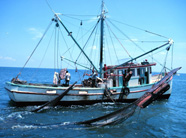
A vessel used in the shrimp fishery in the Gulf of Mexico. (Photo: Robert K. Brigham)
|
fishery - all the activities involved in catching a species of fish (or other aquatic organisms) or a group of species; the sum of all fishing activities on a given resource, e.g. a shrimp fishery, or activity of catching fish from one or more stocks, e.g. the North Sea cod fishery, or it may also refer to a single type or style of fishing, e.g., trawl fishery |
fishery closure area - a fishery which is closed or restricted by a government entity. Such closure prohibits fishing for commercial, recreational, or subsistence purposes |
Fishery Conservation and Management Act - the federal law that created the regional councils and is the federal government’s basis for fisheries management in the EEZ. Also known as the Magnuson Act after a chief sponsor, Senator Warren Magnuson of Washington State |
fishery management council - a regional, quasi-governmental group with authority to manage fisheries in federal waters, generally from three to 200 miles offshore |
fisheye lens - an ultra-wide angle lens giving 180o angle of view. The widest fisheye lenses produce a circular and very distorted image |
fishing mortality - deaths in a fish stock caused by fishing |
fissure - a deep and narrow depression cutting across the reef front with origins relating to jointing planes in the reef limestone or non-limestone bedrock |
fistula - an abnormal passage between two organs or between an organ and the outside of the body. Fistulae are caused by ulceration, congenital malformation, or when damaged tissues come into contact with each other and join together while healing |
fistule - in sponges, a tubular structure on the upper surface, upon which the osculum is situated. A fistule is frequently found on species that burrow into mud or excavate coral |
fitness - the potential evolutionary success of an allele or genotype, which is defined as the reproductive success or the proportion of genes that an individual leaves in the gene pool of a population (expected contribution to future generations). The individuals with the greatest fitness leave the largest numbers of offspring.The fitness of genes and organisms is always relative to the other genes and organisms that are present in the same population |
fitness landscape - in evolutionary biology, fitness landscapes are used to visualize the relationship between genotypes (or phenotypes) and reproductive success. It is assumed that every genotype has a well defined replication rate (often referred to as "fitness") This fitness is the "height" of the landscape. Genotypes which are very similar are said to be "close" to each other, while those that are very different are "far" from each other. The two concepts of height and distance are sufficient to form the concept of a "landscape". The set of all possible genotypes, their degree of similarity, and their related fitness values is then called a fitness landscape; also called "adaptive landscape" |
five prime and three prime ends (5' and 3' ends) - a double stranded DNA (the double helix) always has an orientation or directionality. Because of this directionality, the nucleotides along one strand are heading in one direction (e.g. the 'ascending strand') and the others are heading the other (e.g. the 'descending strand'). For reasons of chemical nomenclature, the asymmetric termini of each strand are called the 5' and 3' ends (pronounced "five prime" and "three prime"). Nucleotide sequences are read by enzymes in the "5' to 3' direction". In a vertically oriented double helix, the 3' strand is said to be ascending while the 5' strand is said to be descending |
fixed action pattern - in ethology or animal behavior, a complex behavioral response which once released by a key stimulus, runs to completion. It is performed in a very similar way by its individual members; also called " modal action pattern" because of individual variations in behavior |
fjord - a deep-water inlet, carved out by glacial action and usually surrounded by mountains or steep slopes |
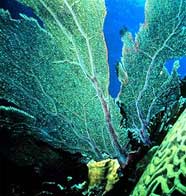
A flabelliform Gorgonia (Photo: NOAA)
|
flabellate - fan-shaped |
flabelliform - fan-shaped |
flaccid - limp, flabby, lacking in firmness |
flagellate - a unicellular protist with one or more flagella, a whip-like organelle often used for propulsion; having or resembling a lash or whip (as does a flagellum) |
flagellated chamber - in sponges, an internal cavity that is lined with choanocytes |
flagelliform - whip-shaped |

A bacterium with a whip-like flagellum. (Photo: U.S. National Institutes of Health)
|
flagellum - a whip-like appendage used for locomotion in sperm cells and some bacteria, fungi, and protists |
flagship species - popular, charismatic, socially appealing species that serve as symbols and rallying points to evoke public sympathy and stimulate conservation awareness and action. Whales, seals, sea lions, and marine turtles are flagship species |
flange - a projecting rim |
flaring corallite - a corallite with expanding, trumpet-like curves to the outer corallite wall |
flat - very shallow and still water, usually with a sand or mud bottom |
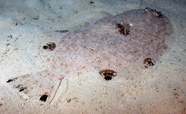
A flatfish lying on a sandy bottom in the Flower Garden Banks. (Photo: NOAA/FGBNMS)
|
flatfish - any fish species in the order Pleuronectiformes, which includes flounders, flukes, dabs, halibuts, plaice, soles, and turbots. All flatfishes have an unusualy compressed body form adapted to life on the bottom. As the bilaterally symmetrical immature forms develop, one eye migrates to either the left or right side, depending upon the species. The body compresses laterally with changes in the skeletal and internal organ systems, and the animal rests on either its left or right side. The side on the bottom is pale, while the other side is strongly pigmented. Some species are able to change their pigmentation to match the appearance of the bottom |
flavescent - yellowish color |
flipper - the phenomenon in which the sex of the offspring is determined by environmental factors |
flock - a socially coordinated group of birds |
flood tide - the phase of the tide between low water and the subsequent high tide; a rising tide |
floodplain - a lowland along a riverbank, lake, and coastline which is subjected to periodic inundation |
flora - the entire group of plants found in an area |
Florida Atlantic Coast Telemetry Project (FACT) - the FACT Project is a local-state-federal cooperative of researchers using acoustic telemetry, or fish tracking, to better understand the movements, reproduction, life-cycle and habitat-use patterns of multiple commercially and ecologically important fishes along Florida’s Atlantic coast – from Mosquito Lagoon at the northern extent to Lake Worth Inlet to the south |
Florida Current - the segment of current between the Gulf of Mexico Loop Current and the Gulf Stream, from the Dry Tortugas to the southeastern tip of Florida, and confined by the 250 meter and 500 meter isobaths |
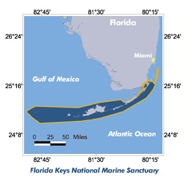
The Florida Keys National Marine Sanctuary. (Graphic: NOAA)
|
Florida Keys National Marine Sanctuary - the Florida Keys National Marine Sanctuary was designated as a national marine sanctuary in November of 1990. The Florida reef tract is the most extensive living coral reef system in North American waters and the third largest barrier reef system in the world. The sanctuary extends 220 miles in a northeast to southwest arc between the southern tip of Key Biscayne, south of Miami, to beyond, but not including the Dry Tortugas Islands |
Florida Reef tract - the third largest barrier reef in the world, running from the Miami area southwest to the Dry Tortugas |
floridean starch - a carbohydrate which is the chief food reserve in red algae (Rhodophycota). It is a branched polymer of glucose similar to amylopectin of green plants. It occurs as granules in the cytoplasm |
floriform - flower-shaped |
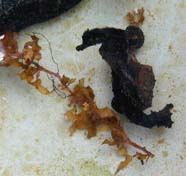
Seahorses caught in flotsam off the Colombian/Panamanian coast. (Photo: NOAA)
|
flotsam - wreckage or discarded material, e.g. garbage, found floating on the surface of the ocean or washed up on the beach |
flow cytometry - a technique used to sort cells or other biological materials by means of flow through apertures of defined size or by laser sorting |
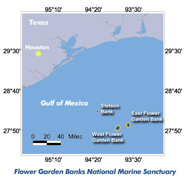
Graphic depicting location of the Flower Garden Banks National Marine Sanctuary in the Gulf of Mexico.
|
Flower Garden Banks National Marine Sanctuary - the Flower Garden Banks National Marine Sanctuary was designated as a national marine sanctuary on January 17, 1992. The sanctuary is located about 110 miles off the coasts of Texas and Louisiana, and harbors the northernmost coral reefs in the United States and serves as a regional reservoir of shallow water Caribbean reef fishes and invertebrates. The coral reefs rise to within 66 feet of the surface. The area containing both the East and West Banks is 41.7 square nautical miles in size and contains 350 acres of reef crest. In October 1996, Congress expanded the sanctuary by adding a small third bank, Stetson Bank, located about 70 nautical miles south of Galveston, Texas. Environmental conditions at Stetson Bank do not support the establishment and growth of coral reefs |
fluctuating asymmetry (FA) - a pattern of small, random deviations between sides in the size of a given trait - the random component of bilateral asymmetry, i.e., subtle random deviations from perfect bilateral symmetry. It arises when genetic or environmental stressors disrupt developmental processes that normally promote symmetrical growth. Fluctuating asymmetry is of particular interest because of its potential as a biomonitor of environmental quality. It is a relatively new tool for assessing the impact of environmental and genetic stresses on populations. One of the main advantages of FA is its increased sensitivity relative to other bioindicators. If effective, this tool could allow biologists to monitor populations and make recommendations before a severe problem arises, often without the high cost of other solutions |
fluorescence - the emission of light from a substance caused by exposure to radiation from an external source |
fluorescent pigment - a pigment that absorbs light at one wavelength and emits it at a different wavelength. The emitted light usually has a lower energy than the light absorbed by the pigment |
fluorometer - an instrument for measuring fluorescence |
flushing - the exchange of water between an estuary or coastal waterway and the ocean |
flushing time - the time required for a waterbody, e.g., an inlet, estuary, marina, etc. to exchange its water with water from the parent waterbody |
fluting - grooves in the shaft of a column |
flux - the rate of flow of energy or particles across a given surface |
flyway - a broad-front band or pathway used in bird migration |
focal species - the species that is identified as being most sensitive to a threat in a changing environment. Species are being lost from areas in which their habitats are being destroyed, fragmented or simplified. Focal species can be used to identify the appropriate spatial and functional parameters that must be present in an environment if it is to retain the biota that occurs there |
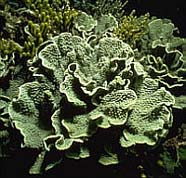
Foliaceous coral. (Photo: NOAA)
|
foliaceous - leaf-like; also foliose |
foliose coral - a coral whose skeletal form approximates that of a broad, flattened plate |
food chain / food web - all the interactions of predator and prey, included along with the exchange of nutrients into and out of the ecosystem. These interactions connect the various members of an ecosystem, and describe how energy is converted and passes from one organism to another |
food pyramid - pyramid-shaped diagram which shows feeding relationships within a food chain, e.g. that herbivores are smaller, more numerous and faster breeding than the predators that feed on them |
foot - in mollusks, the structure found on the animal's ventral side, that consists primarily of muscle, and is modified for locomotion, food gathering, and digging |
forage - to search for food |
forage fishes - small fishes which which occur in large numbers and serve as food for predatory fishes |
foramen - an opening in a structure |
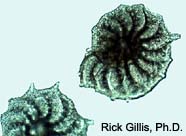
These foraminiferans have a test composed of calcium carbonate. (Photo: Rick Gillis, Ph.D., Biology Dept., University of Wisconsin-La Crosse)
|
Foraminifera - planktonic and benthic protozoan protists that have a test (shell) composed of calcium carbonate |
fore reef - the portion of a reef seaward of reef crest. A synonym of reef slope |
fore reef escarpment - a slope or cliff seaward of the fore reef terrace, at a depth of about 25-30m |
fore reef slope - a sand covered, gradual or sharply descending slope; the next-to-deepest part of the fore reef |
fore reef terrace - the uppermost portion of the fore reef; a flat plain beginning at the base of the buttress or mixed zone, at a depth of about 60 m |
foreign DNA - refers to any deoxyribonucleic acid (DNA) which originates outside of the organism of concern or study; also referred to as exogenous DNA or heterologous DNA |
foreign fishing - fishing by a foreign (non-U.S.) fishing vessel (Magnuson-Stevens Fishery Conservation and Management Act) |
formal metadata - metadata that follows an FGDC approved standard |
formalin - formaldehyde gas dissolved in water. Formalin is used as a fixative and preservative in some collections of biological specimens |
formenkreis - a group of related allopatric species or subspecies |
fossa - a hole or cavity in the coral skeleton |
fossorial - adapted for a digging or burrowing life style or behavior |
founder effect - in evolution, the effect of establishing a new population by a small number of individuals, carrying only a small fraction of the original population's genetic variation. As a result, the new population may be distinctively different, genotypically and phenotypically, from the parent population from which it is derived. In extreme cases, the founder effect is thought to lead to the speciation and subsequent evolution of new species |
foveolate corallite - a corallite of some species which is located at the base of a funnel-shaped depression |
FRA (Fish Replenishment Area) - a designated area, within a Fisheries Management Area (FMA), where certain specified fish harvesting activities are prohibited |
fractal - the smallest part of a mathematical set of numbers which when repeated or scaled will maintain the primary permutation; an object which is self-similar at all scales. Regardless of scale the same level of detail and appearance is present |
fractal geometry - a method to study shapes that are self-similar over many scales |
fragmentation - a type of asexual reproduction common in branching corals. Branches break off from the parental colony to establish other colonies nearby |
framework - a rigid, wave resistant calcareous structure constructed by sessile organisms such as sponges, corals, and bryozoans, in a high energy environment |
free - unconstrained or not chemically bound in a molecule or not fixed and capable of relatively unrestricted motion |
free dive - diving without the assistance of any breathing apparatus, such as scuba |
free energy - the usable energy in the bonds of a molecule; energy that is available to do useful work. A decrease in free energy accompanies any spontaneous process |
free radical - an atom or group of atoms possessing an unpaired electron; free radicals are highly reactive and bind with other molecules, thus disrupting normal cellular processes and causing cellular damage (oxidative stress) |
free-living coral - a coral which is not attached to a substrate |
freely associated state - an "associated state" is used to describe a free relationship between a territory and a larger nation. The details of an association are specific to the countries involved. This is also known as "free association." The Federated States of Micronesia, the Republic of Palau, and the Republic of the Marshall Islands are associated with the United States under what is known as the Compact of Free Association. Under this relationship the states possess international sovereignty and ultimate control over their territory. However, the governments of those areas have agreed to allow the United States to provide defense, funding grants, and access to US social services for citizens of these areas |
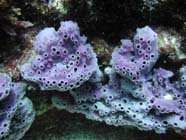
Sponges in French Frigate Shoals reef. (Photo: NOAA)
|
French Frigate Shoals - an open atoll in the Northwest Hawaiian Islands (NWHI) that consists of a large, crescent-shaped reef surrounding numerous small, sandy islets. While the land area is only one-fourth square kilometer (67 acres), the total coral reef area of the shoals is over 938 square kilometers (232,000 acres). The reef system associated with French Frigate Shoals supports the greatest variety of coral species in the NWHI, with 41species of stony corals documented. It also supports more than 600 species of invertebrates, many of which are endemic to the area, over 150 species of algae, and many species of fishes. Hundreds of green sea turtles travel to the shoals for safe nesting. The many small islets of French Frigate Shoals also provide refuge to the largest sub-population of endangered Hawaiian monk seals |
frequency - the number of items occurring in a given category |
frequency - the number of cycles of a wave per second. Frequency is expressed as units of Hertz (Hz) |
frequency distribution - a graphical, tabular, or mathematical representation of the manner in which the frequencies of a continuous or discrete random variable are distributed over the range of its possible value |
frequency of recombination - the number of crossover events observed between two linked loci expressed as a proportion of the total number of meioses sampled |
freshwater lens - an underground pool of freshwater that takes the shape of a lens. Lenses are critical sources of fresh water on many islands. The freshwater lens is suspended by seawater. For example, when rain falls on a limestone island, it quickly sinks into the porous calcareous rock, picking up a mineral content from the organic material, soil and rock that it passes through. This water accumulates within the rock, continuing it’s downward path. Eventually, it meets the layer of salt water that permeates limestone platforms at sea level. Because fresh water is less dense than salt water, the lens of fresh water will float on top of the saline groundwater. In many areas, this lens is very thin. If the sea level increases and/or if the lens becomes depleted because of excess withdrawals, seawater can intrude and make the water unsuitable for many uses. The size of the lens is directly related to the size of the island. Larger islands have lenses that are less vunerable to tidal mixing and excessive withdrawals |
friction - the mechanical resistive force offered by one medium or body to the relative motion of another medium or body in contact with the first; also called "frictional force" |
frictional drag - the molecular (viscous) retarding force on an object, such as air, as it moves across the earth's surface |
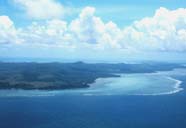
A fringing reef off a South Pacific Island.
|
fringing reef - a shelf reef that grows close to shore. Some develop around oceanic islands. A synonym of shore reef |
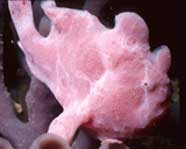
Closeup of a pink frogfish perched on a purple sponge (Photo: Jeff Dawson)
|
frogfish - any of over 40 species of bony fishes in the family Antennariidae. They are small globose fishes with loose prickly skin, limb-like pectoral fins with an elbow-like joint, small round gill openings, and a very large upward directed mouth. The first dorsal spine is modified into a moveable fishing rod (Illicium) tipped with a lure (esca) |
frond - a leaf-like thallus, such as the body of a kelp |
front - a boundary or transition zone between two air or water masses of different properties |
frontal threat display - agonistic display behavior in which a fish faces another fish and flares its gill covers (opercula) and opens its mouth wide. This behavior may indicate aggression, territoriality or self defense (by making it appear too large to attack or eat) |
frugivore - an animal which primarily eats fruit |
frustule - a nonciliated, planula-like cnidarian larva. It constricts off from a polyp, creeps along the substrate, settles, and develops into a polyp; the siliceous shell of a diatom |
fry - newly hatched, active feeding post larval fishes; may include all fish stages from hatching to fingerling |
fucosyltransferase inhibito - a suspected antiinflammation and antitumor compound isolated from marine sponges in the genus Sarcotragus |
full thickness - in histopathology, a lesion, wound or process that involves all layers of tissues in a structure. For example in the body wall of a polyp, the epidermis, mesoglea, and gastrodermis ; also called "transmural" |
fulvous - dark yellow, orange-yellow |
fulvous - dull yellow color |
fundamental niche - the full range of physical, chemical, and biological factors a species could use if there were no competition from other species |

Fungi growing in an Oregon woodland. (Photo: Carol Baldwin, NOAA/OMAO)
|
Fungi - the Kingdom of usually multicellular, heterotrophic eukaryotes that have multinucleated cells enclosed within cell walls. Nutrition is obtained by decomposing dead and dying organisms and absorbing the decomposition products |
fungicide - a chemical compound used to retard or prevent the growth of fungi |
funnel organ - a structure, common in several phyla, that leads from the coelom to the outside and may be used for waste elimination and/or reproduction (Annelida, Brachiopoda, and other small phyla); the modified tubular opening of the mantle cavity in cephalopods used in generating a stream of water for use in locomotion |
furcate - to divide into branches; to fork |
fusiform - a shape that is tapered at both ends; spindle-shaped; torpedo-shaped, like a mackerel |
|
|
|
|

